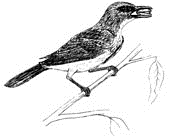Vertebrate Pest Conference: Proceedings

Vertebrate Pest Conference Proceedings: 17th (1996)
Date of this Version
1996
Document Type
Article
Citation
Published in Proceedings: Seventeenth Vertebrate Pest Conference … 1996, ed. Robert M. Timm & A. Charles Crabb (University of California, Davis, 1996).
Abstract
A wild house mouse (Mus domesticus) population originally trapped near Reading, Berkshire, United Kingdom, and maintained as a colony in the laboratory, was subjected to the discriminating feeding period of the warfarin resistance test, as used by Wallace and MacSwiney (1976) and derived from the work of Rowe and Redfern (1964). Eighty percent of this heterogeneous population survived the resistance test. A similar proportion of the population was found to survive the normally lethal dose of bromadiolone administered by oral gavage. The majority of this population of mice were classified as "warfarin-resistant" and "bromadiolone-resistant." The dose of l0 mg kg-1 of bromadiolone administered by oral gavage appeared to give good discrimination between susceptible and resistant individuals. The results of breeding tests indicate a single dominant gene that confers both "warfarin-resistance" and "bromadiolone-resistance," with complete expression of the resistance genotype in both males and females. Individual mice were classified as to genotype by back-crossing to a homozygous-susceptible strain, and resistance-testing the F1 generation. Separate strains of homozygous-resistant and homozygous-susceptible house mice are now being established.
Included in
Animal Sciences Commons, Bioresource and Agricultural Engineering Commons, Environmental Engineering Commons


Comments
Copyright © 1996 (where applicable) by the Vertebrate Pest Council of the Vertebrate Pest Conference. Used by permission.